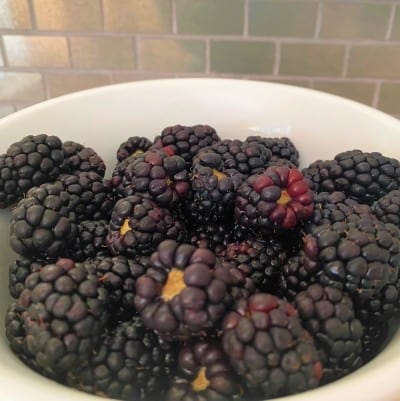You know you’re supposed to eat fruits and vegetables every day, so I’m going to share the easiest and best way to wash them: water 💧.
Fresh, running water is very effective at removing bacteria, pesticide residues, and dirt from produce.
Scientists and nutrition experts agree that you don’t need to spend money on produce washes, or use soap, vinegar, or, God forbid, anything stronger.

Would you like to save this recipe or article?
You won't get spam from me, I promise!
I earn from qualifying purchases at no extra cost to you as part of the Amazon Affiliate program.
Everyone should enjoy five servings of a variety of fruits and vegetables every day!
Why wash fresh produce?
Any produce purchased from a market or grocery store or grown in a home garden needs a bath. Remember that, especially if your haul was purchased, it was handled often before you picked it out and took it home.

Grocery store, farmer’s market, roadside fruit-and-vegetable stands: It doesn’t matter where you got the produce; it will have remnants of soil and dirt, as well as potential pesticide residues.
FYI: Organic produce is not exempt from washing! Despite farming practices that rely on crop management practices and the use of primarily natural, not synthetic, pesticides, it’s not clean until washed.
Pesticides can harm health in several ways:
- Linked to cancer
- DNA damage
- Brain damage
- General poison
However, if the price of organic produce is too high, buy regular produce and save money while doing your health a world of good!
It’s better to eat all sorts of fruits and veggies, organic or not! Just be sure and wash them in water.
Common methods of cleaning produce–are they worth it?

Some people employ special methods to clean fruits and veggies:
- Baking soda and water
- Produce washes
- Soaking in water for period of time
- Vinegar solution
According to a study done with apples, baking soda mixed with water can clean produce, particularly if you soak the item for 12 to 15 minutes. However, water also does the job well, especially if you rub the outside of the fruit while rinsing.
The FDA recommends against using produce washes because their safety has not tested by the agency, and they may leave residues.
If you’re going to soak in water, please use a clean bowl or container and not the sink. Even many of the cleanest sinks can harbor and spread bacteria.
Soaking in a 5% vinegar solution may be a good treatment for items like leafy greens or any produce with nooks and crannies where bacteria and pesticide residues can hang out. Keep in mind that vinegar may change the taste of your greens!
According to this recent study, rinsing with clean water removed greatest number of pesticides from leafy greens. It’s worth noting that the researchers rinsed them for five minutes!
⚠️Never use bleach or disinfectants! Produce is porous and applying these chemicals can make it unsafe to eat.
How to wash produce with running water
Wash your hands for 20 seconds, lathering with soap and rinsing with clean water.
Place fruit or veggie under a stream of clean, cool, running water and rinse per the CDC.
If the fruit or vegetable has a smoother surface, rub it with your hands and fingers while rinsing. If the exterior is tough enough, (affiliate link) use a brush on it. This works great for melons, apples, oranges, carrots, celery, etc.
Dry with a clean kitchen towel or a paper towel.
FAQ
No. Especially if you’re going to cut and trim the item. You can spread bacteria to the interior with the knife used to cut through it.
You might like this (affiliate link) paring knife for trimming and this (affiliate link) chef's knife for slicing.
If you reach a temperature of 165 F, all bacteria are killed immediately. However, you must wash before cooking because it does not necessarily remove pesticides.
I highly recommend using an instant-read thermometer!
❤️🩹Special Care
Certain people need to be more careful with fresh fruit and vegetables. Infection from dirty produce can result in serious illness for older adults and children younger than 5, as well as for anyone with an immune problem.
This last group includes anyone with HIV, cancer, asthma, or diabetes. Some of these may need to focus on cooked rather than raw produce.
Certain fruits and veggies are very difficult to clean with certainty. These include:
- Cantaloupes: The irregular surface is a haven for bacteria. Be sure to clean them thoroughly with a brush.
- Sprouts: The warm, humid environment necessary for growing them promotes bacterial growth. These are almost constantly in the news for recalls. Eat them at your own risk!

Tips for vibrant, healthy produce
- Remove the outer leaves. These contain more pesticides and bacteria and have had more handling. Expect the worst.
- Cut away damaged, rotten, or bruised areas. Usually weather marks on apples, pears, and stone fruit are fine and do not need removal.
- Always refrigerate cut or cooked produce within two hours. If the temperature is above 90 F, make this happen within one hour.
🙏🏼Health Plea
Don’t let the task of washing fruits and vegetables keep you from eating them. Here’s where you’ll find the nutrition gold: antioxidants, fiber, phytonutrients, vitamins, and minerals.💛
Enjoy the sweet crunch of an apple or a carrot, the juicy goodness of a melon or a tomato, and delicious salads made with leafy greens and cabbages.
Nutrition experts agree that it’s hard to eat in a way that fuels a healthy lifestyle if you avoid fruits and vegetables. Rinse with clean water and eat to your heart’s content! 😍

Fresh Recipes
Here are a couple of side dishes that focus on fresh produce:
Asparagus in Foil Packets: For the grill or the oven. To keep the spears from wilting, only cook them for a few minutes.
🍅Roasted Tomato Chutney: If salsa and ketchup had a baby, it would taste like this spicy condiment that is marvelous with chicken, fish, pork, or tofu.

Copyright © 2024 Jani H. Leuschel






Leave a Reply